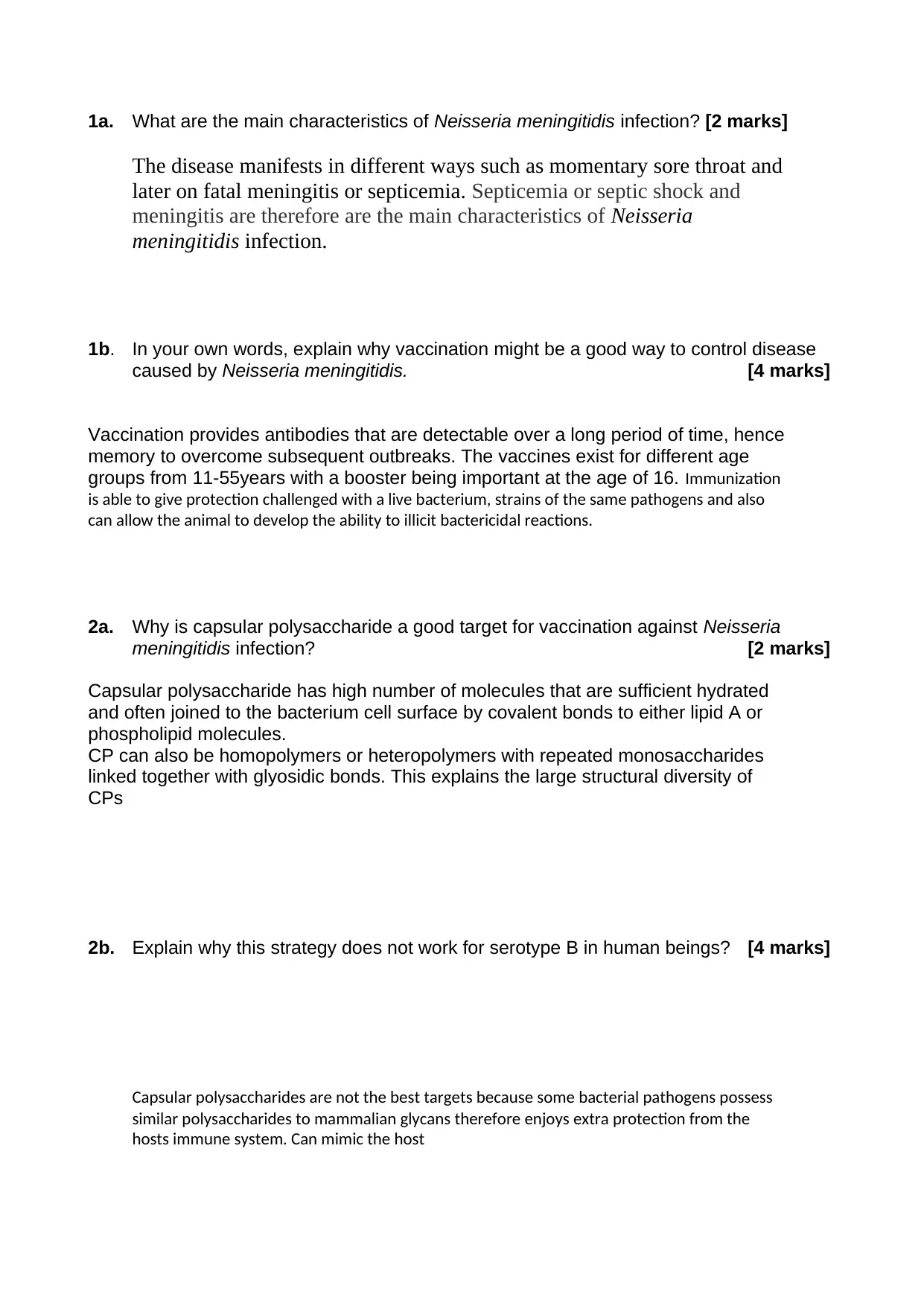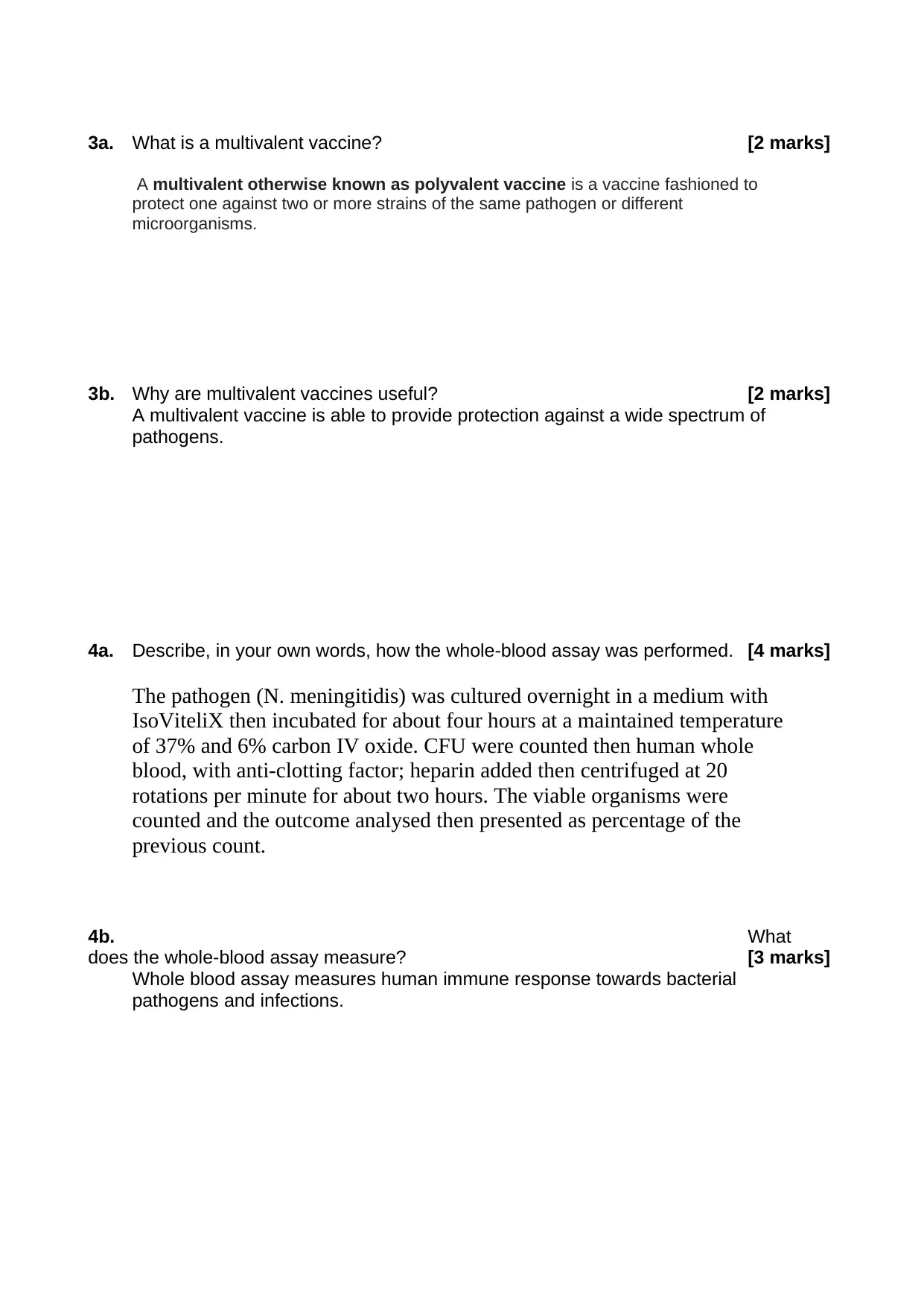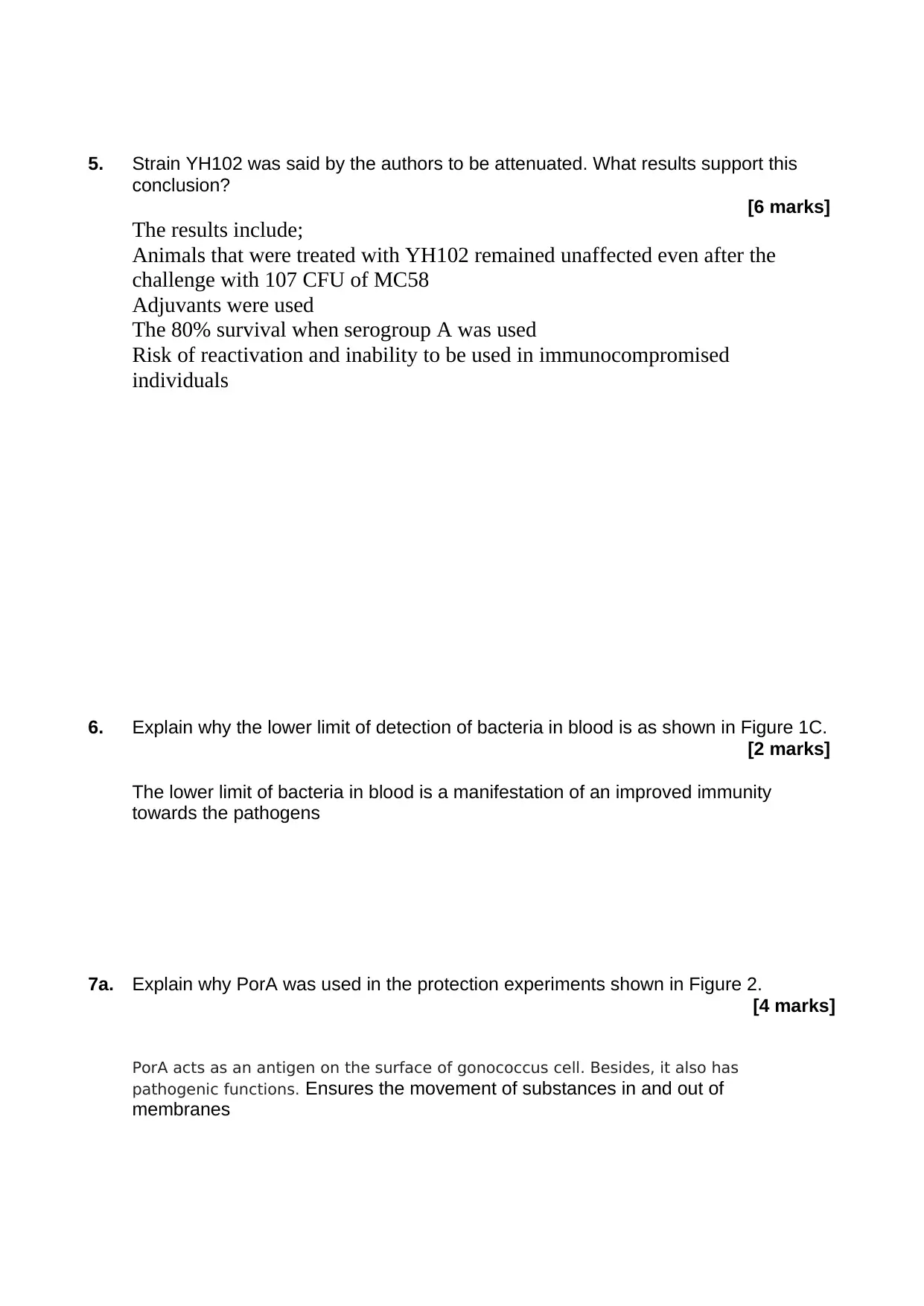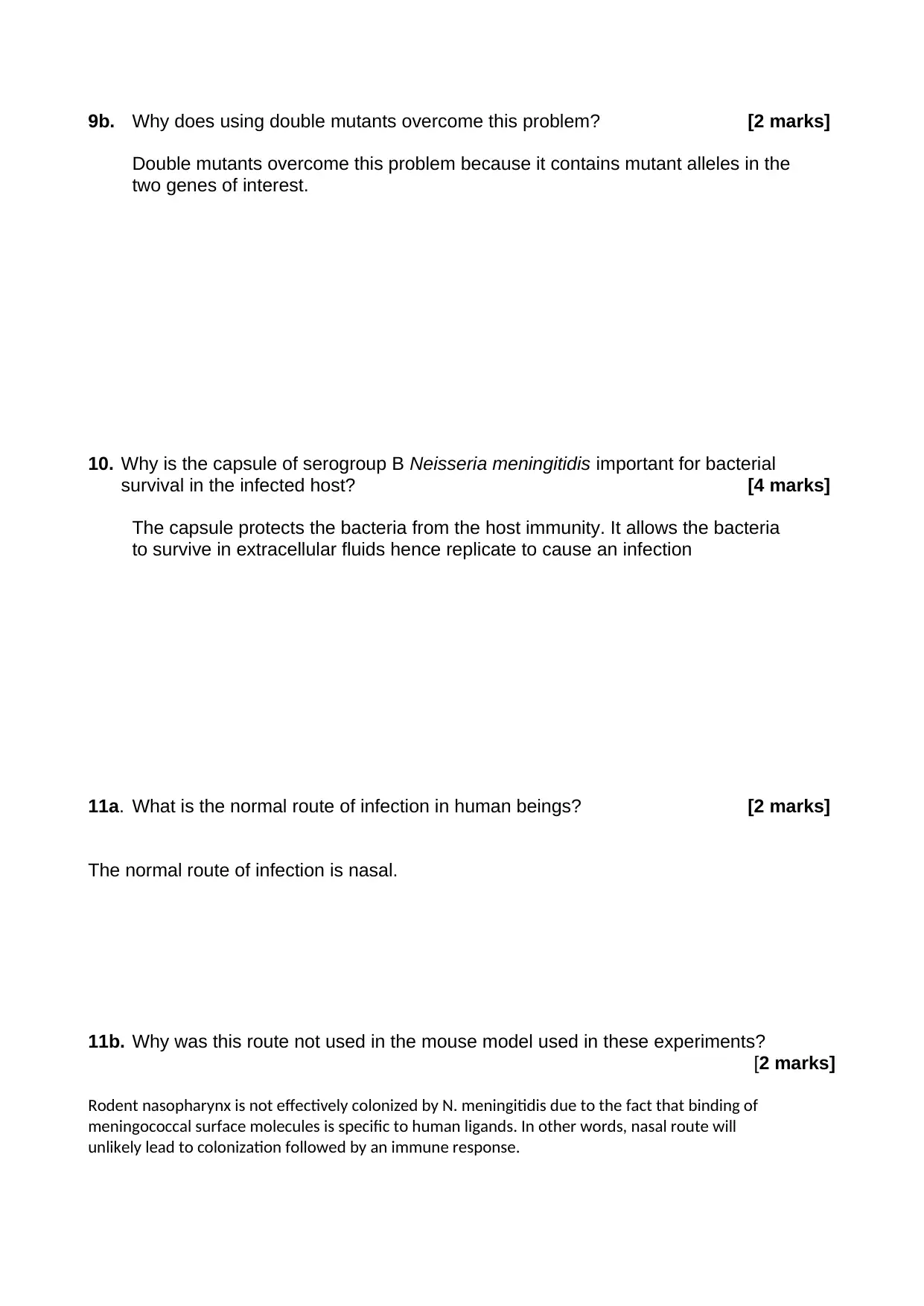Literature Comprehension Test: Neisseria meningitidis and Immunity
VerifiedAdded on 2022/10/10
|10
|1230
|418
Homework Assignment
AI Summary
This assignment presents a student's comprehensive responses to a literature comprehension test centered on the research paper by Li et al. (2004) regarding vaccination with attenuated Neisseria meningitidis strains. The test delves into the characteristics of Neisseria meningitidis infection, the rationale behind vaccination strategies, and the efficacy of capsular polysaccharides as vaccine targets. It explores the concept of multivalent vaccines, the methodology of the whole-blood assay, and the significance of attenuated strains. The assignment also examines the role of PorA in protection experiments, the usefulness of YH102 and YH103 as vaccine candidates, and the risks associated with attenuated meningococcal organisms. Furthermore, it investigates the importance of the serogroup B Neisseria meningitidis capsule, the normal route of infection, and the implications for individuals at increased risk. The student provides detailed explanations, interpretations, and analyses of the research findings, demonstrating a strong understanding of the concepts of infection and immunity.

Microorganisms, Infection and Immunity 2.
LITERATURE COMPREHENSION TEST
The questions in this paper refer to: Li Y et al (2004). Vaccination with attenuated
Neisseria meningitidis strains protects against challenge with live meningococci.
Infection and Immunity 72: 345-351.
• Most questions can be answered quite briefly, often in a single sentence. It will
be to your advantage to keep your answers concise and to the point.
• The maximum mark available for each question is shown in brackets.
• The questions vary in difficulty. Some require you to interpret the paper rather
than to discover a particular answer within it.
• Do not rely on simple copying from the paper. Some answers will require a more
thoughtful approach involving deduction or interpretation. In general, marks will
be higher if you use your own words, and present evidence of understanding.
LITERATURE COMPREHENSION TEST
The questions in this paper refer to: Li Y et al (2004). Vaccination with attenuated
Neisseria meningitidis strains protects against challenge with live meningococci.
Infection and Immunity 72: 345-351.
• Most questions can be answered quite briefly, often in a single sentence. It will
be to your advantage to keep your answers concise and to the point.
• The maximum mark available for each question is shown in brackets.
• The questions vary in difficulty. Some require you to interpret the paper rather
than to discover a particular answer within it.
• Do not rely on simple copying from the paper. Some answers will require a more
thoughtful approach involving deduction or interpretation. In general, marks will
be higher if you use your own words, and present evidence of understanding.
Paraphrase This Document
Need a fresh take? Get an instant paraphrase of this document with our AI Paraphraser

1a. What are the main characteristics of Neisseria meningitidis infection? [2 marks]
The disease manifests in different ways such as momentary sore throat and
later on fatal meningitis or septicemia. Septicemia or septic shock and
meningitis are therefore are the main characteristics of Neisseria
meningitidis infection.
1b. In your own words, explain why vaccination might be a good way to control disease
caused by Neisseria meningitidis. [4 marks]
Vaccination provides antibodies that are detectable over a long period of time, hence
memory to overcome subsequent outbreaks. The vaccines exist for different age
groups from 11-55years with a booster being important at the age of 16. Immunization
is able to give protection challenged with a live bacterium, strains of the same pathogens and also
can allow the animal to develop the ability to illicit bactericidal reactions.
2a. Why is capsular polysaccharide a good target for vaccination against Neisseria
meningitidis infection? [2 marks]
Capsular polysaccharide has high number of molecules that are sufficient hydrated
and often joined to the bacterium cell surface by covalent bonds to either lipid A or
phospholipid molecules.
CP can also be homopolymers or heteropolymers with repeated monosaccharides
linked together with glyosidic bonds. This explains the large structural diversity of
CPs
2b. Explain why this strategy does not work for serotype B in human beings? [4 marks]
Capsular polysaccharides are not the best targets because some bacterial pathogens possess
similar polysaccharides to mammalian glycans therefore enjoys extra protection from the
hosts immune system. Can mimic the host
The disease manifests in different ways such as momentary sore throat and
later on fatal meningitis or septicemia. Septicemia or septic shock and
meningitis are therefore are the main characteristics of Neisseria
meningitidis infection.
1b. In your own words, explain why vaccination might be a good way to control disease
caused by Neisseria meningitidis. [4 marks]
Vaccination provides antibodies that are detectable over a long period of time, hence
memory to overcome subsequent outbreaks. The vaccines exist for different age
groups from 11-55years with a booster being important at the age of 16. Immunization
is able to give protection challenged with a live bacterium, strains of the same pathogens and also
can allow the animal to develop the ability to illicit bactericidal reactions.
2a. Why is capsular polysaccharide a good target for vaccination against Neisseria
meningitidis infection? [2 marks]
Capsular polysaccharide has high number of molecules that are sufficient hydrated
and often joined to the bacterium cell surface by covalent bonds to either lipid A or
phospholipid molecules.
CP can also be homopolymers or heteropolymers with repeated monosaccharides
linked together with glyosidic bonds. This explains the large structural diversity of
CPs
2b. Explain why this strategy does not work for serotype B in human beings? [4 marks]
Capsular polysaccharides are not the best targets because some bacterial pathogens possess
similar polysaccharides to mammalian glycans therefore enjoys extra protection from the
hosts immune system. Can mimic the host

3a. What is a multivalent vaccine? [2 marks]
A multivalent otherwise known as polyvalent vaccine is a vaccine fashioned to
protect one against two or more strains of the same pathogen or different
microorganisms.
3b. Why are multivalent vaccines useful? [2 marks]
A multivalent vaccine is able to provide protection against a wide spectrum of
pathogens.
4a. Describe, in your own words, how the whole-blood assay was performed. [4 marks]
The pathogen (N. meningitidis) was cultured overnight in a medium with
IsoViteliX then incubated for about four hours at a maintained temperature
of 37% and 6% carbon IV oxide. CFU were counted then human whole
blood, with anti-clotting factor; heparin added then centrifuged at 20
rotations per minute for about two hours. The viable organisms were
counted and the outcome analysed then presented as percentage of the
previous count.
4b. What
does the whole-blood assay measure? [3 marks]
Whole blood assay measures human immune response towards bacterial
pathogens and infections.
A multivalent otherwise known as polyvalent vaccine is a vaccine fashioned to
protect one against two or more strains of the same pathogen or different
microorganisms.
3b. Why are multivalent vaccines useful? [2 marks]
A multivalent vaccine is able to provide protection against a wide spectrum of
pathogens.
4a. Describe, in your own words, how the whole-blood assay was performed. [4 marks]
The pathogen (N. meningitidis) was cultured overnight in a medium with
IsoViteliX then incubated for about four hours at a maintained temperature
of 37% and 6% carbon IV oxide. CFU were counted then human whole
blood, with anti-clotting factor; heparin added then centrifuged at 20
rotations per minute for about two hours. The viable organisms were
counted and the outcome analysed then presented as percentage of the
previous count.
4b. What
does the whole-blood assay measure? [3 marks]
Whole blood assay measures human immune response towards bacterial
pathogens and infections.
⊘ This is a preview!⊘
Do you want full access?
Subscribe today to unlock all pages.

Trusted by 1+ million students worldwide

5. Strain YH102 was said by the authors to be attenuated. What results support this
conclusion?
[6 marks]
The results include;
Animals that were treated with YH102 remained unaffected even after the
challenge with 107 CFU of MC58
Adjuvants were used
The 80% survival when serogroup A was used
Risk of reactivation and inability to be used in immunocompromised
individuals
6. Explain why the lower limit of detection of bacteria in blood is as shown in Figure 1C.
[2 marks]
The lower limit of bacteria in blood is a manifestation of an improved immunity
towards the pathogens
7a. Explain why PorA was used in the protection experiments shown in Figure 2.
[4 marks]
PorA acts as an antigen on the surface of gonococcus cell. Besides, it also has
pathogenic functions. Ensures the movement of substances in and out of
membranes
conclusion?
[6 marks]
The results include;
Animals that were treated with YH102 remained unaffected even after the
challenge with 107 CFU of MC58
Adjuvants were used
The 80% survival when serogroup A was used
Risk of reactivation and inability to be used in immunocompromised
individuals
6. Explain why the lower limit of detection of bacteria in blood is as shown in Figure 1C.
[2 marks]
The lower limit of bacteria in blood is a manifestation of an improved immunity
towards the pathogens
7a. Explain why PorA was used in the protection experiments shown in Figure 2.
[4 marks]
PorA acts as an antigen on the surface of gonococcus cell. Besides, it also has
pathogenic functions. Ensures the movement of substances in and out of
membranes
Paraphrase This Document
Need a fresh take? Get an instant paraphrase of this document with our AI Paraphraser


7b. What do the results suggest about the relative efficacy of PorA? [2 marks]
PorA is a vital component of protein-based vaccines against meningococcal disease despite the
fact that it exhibits some level of variation.
8a. Describe the results shown in Figure 3B. [5 marks]
YH1o2 is capable of inducing bactericidal response when challenged with
serogroups. From this graph, it is clear that the shorter the time taken, the
higher the chances of survival within the human host. This is because of the
distinctive variations within the immune cells of different individuals.
8b. Explain what the results shown in Figure 2 and Figure 3 suggest about the
usefulness of YH102 and YH103 as a possible vaccine candidate. [2 marks]
YH102 and YH103 illicit immune response against bacterial pathogens.
9a. What is the main risk when using attenuated meningococcal organisms as vaccines?
[2 marks]
Attenuated meningococcal organisms’ vaccines cannot be administered to
people with supressed immunity as there is risk that the pathogen could get
stronger and cause sickness. Moreover, secondary mutation may lead to a
reversion to virulence.
PorA is a vital component of protein-based vaccines against meningococcal disease despite the
fact that it exhibits some level of variation.
8a. Describe the results shown in Figure 3B. [5 marks]
YH1o2 is capable of inducing bactericidal response when challenged with
serogroups. From this graph, it is clear that the shorter the time taken, the
higher the chances of survival within the human host. This is because of the
distinctive variations within the immune cells of different individuals.
8b. Explain what the results shown in Figure 2 and Figure 3 suggest about the
usefulness of YH102 and YH103 as a possible vaccine candidate. [2 marks]
YH102 and YH103 illicit immune response against bacterial pathogens.
9a. What is the main risk when using attenuated meningococcal organisms as vaccines?
[2 marks]
Attenuated meningococcal organisms’ vaccines cannot be administered to
people with supressed immunity as there is risk that the pathogen could get
stronger and cause sickness. Moreover, secondary mutation may lead to a
reversion to virulence.
⊘ This is a preview!⊘
Do you want full access?
Subscribe today to unlock all pages.

Trusted by 1+ million students worldwide

Paraphrase This Document
Need a fresh take? Get an instant paraphrase of this document with our AI Paraphraser

9b. Why does using double mutants overcome this problem? [2 marks]
Double mutants overcome this problem because it contains mutant alleles in the
two genes of interest.
10. Why is the capsule of serogroup B Neisseria meningitidis important for bacterial
survival in the infected host? [4 marks]
The capsule protects the bacteria from the host immunity. It allows the bacteria
to survive in extracellular fluids hence replicate to cause an infection
11a. What is the normal route of infection in human beings? [2 marks]
The normal route of infection is nasal.
11b. Why was this route not used in the mouse model used in these experiments?
[2 marks]
Rodent nasopharynx is not effectively colonized by N. meningitidis due to the fact that binding of
meningococcal surface molecules is specific to human ligands. In other words, nasal route will
unlikely lead to colonization followed by an immune response.
Double mutants overcome this problem because it contains mutant alleles in the
two genes of interest.
10. Why is the capsule of serogroup B Neisseria meningitidis important for bacterial
survival in the infected host? [4 marks]
The capsule protects the bacteria from the host immunity. It allows the bacteria
to survive in extracellular fluids hence replicate to cause an infection
11a. What is the normal route of infection in human beings? [2 marks]
The normal route of infection is nasal.
11b. Why was this route not used in the mouse model used in these experiments?
[2 marks]
Rodent nasopharynx is not effectively colonized by N. meningitidis due to the fact that binding of
meningococcal surface molecules is specific to human ligands. In other words, nasal route will
unlikely lead to colonization followed by an immune response.

12a. What group of individuals do the authors suggest might show increased risk of
developing meningococcal disease if immunised with attenuated Neisseria
meningitidis? [2 marks]
Individuals suffering from complement insufficiency; persons that have
undergone surgery and other procedures that immunocompromise the body
immunity
12b. Why might this increased risk occur? [2 marks]
They are live microorganisms that may be reactivated and thereby cause
systemic infection
developing meningococcal disease if immunised with attenuated Neisseria
meningitidis? [2 marks]
Individuals suffering from complement insufficiency; persons that have
undergone surgery and other procedures that immunocompromise the body
immunity
12b. Why might this increased risk occur? [2 marks]
They are live microorganisms that may be reactivated and thereby cause
systemic infection
⊘ This is a preview!⊘
Do you want full access?
Subscribe today to unlock all pages.

Trusted by 1+ million students worldwide

1 out of 10
Your All-in-One AI-Powered Toolkit for Academic Success.
+13062052269
info@desklib.com
Available 24*7 on WhatsApp / Email
![[object Object]](/_next/static/media/star-bottom.7253800d.svg)
Unlock your academic potential
Copyright © 2020–2025 A2Z Services. All Rights Reserved. Developed and managed by ZUCOL.
